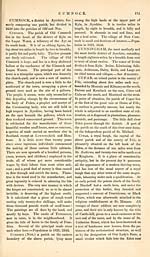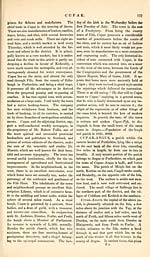Gazetteer of Scotland > Volume 1
(204) Page 176
Download files
Complete book:
Individual page:
Thumbnail gallery: Grid view | List view

176
CUPAR.
the spot. The verdant esplanade In front of
the castle was appropriated, in 1555, for the
performance, sub dio, of David Lindsay's satire
of the Three Estates, a witty drama, principally
levelled at the clergy, and supposed to have
had great influence in bringing about the reli-
gious revolution which soon after ensued. This
very clever poet, the study of whose works
formed, for a long time, part of the education
of every Scotsman, lived at his patrimonial
estate, called the Mount, about four miles
north-west from Cupar, where, instead of a
deserved monument to himself, a pillar has late-
ly been raised to the memory of the Earl of
Hopetoun. It would appear that the castle of
Cupar was long a strength of importance. Be-
ing the head quarters of the Thanes of Fife, the
rude courts of justice of these chiefs were or-
dinarily held here, and on this account the
town early acquired the character of the capi-
tal of the district under their government.
From the vicinity of the castle the houses of the
town spread towards the west, and in process of
time the burgh extended to those limits it now
possesses. Though originating in fortuitous cir-
cumstances of this nature, the situation of the
town could hardly have been better chosen.
It lies on a slight elevation in a secluded vale
open at the east and west, and overhung on the
south by a range of hilly ground. To the
north the country is beautiful and fertile, and
gradually expands to a series of woody emi-
nences. Immediately on the south, at the base
of the superincumbent hill, which is beautified
by plantations and enclosures, flows the Eden ;
a river at this place seeming to partake as
much of the character of an artificial canal, as
of a natural stream, and which is lost in the
sinuosities of the vale to the east. This
brook is crossed by two bridges of stone, and
one of wood. The town is composed of one
principal and rather long street, running from
west to east, which communicates with the
road to Kinross, and another street projected
from the south side of this, near its east end,
which communicates with the road to Edin-
burgh, by means of the upper and more ancient
stone bridge. The centre of the town is at
the junction of these thoroughfares, both of
which are lined with good houses of from one
to three stories in height. East from the
junction of the streets, is a short street, called
St. Catherine Street, composed of very elegant
modern edifices of freestone, erected somewhat
in the style of the secondary parts of the New
Town of Edinburgh. Some spaces of the
street are not yet filled up, but those already
finished do great credit to the taste of the pro-
prietors. On the south side are the county
buildings, a large tontine, and some public
offices and private houses. On the opposite
side stands an episcopal chapel, built in the
same Grecian style, and intended to fill up a
space in the line of street. It almost oc-
cupies the site of the Dominican Monastery
mentioned above. The thoroughfare of
St. Catherine Street leads eastward to the
roads to St. Andrews and Dundee. Be-
tween the different main streets there are
connecting lanes or narrow streets, the whole
of which are kept in a state of the most
praiseworthy cleanliness. The sides of some
of the streets have pavement, a luxury found as
yet in few Scottish country towns, though stead-
ily making its way among them, along with
other improvements. The town and the chief
shops are now lighted with gas manufactured
by a joint-stock company established in 1830.
Around the vicinity are a variety of hand-
some villas and gardens, which add much to
the beauty and respectability of the place.
Nearly in the centre of the town, in a back
street, is situated the church with the common
burying-ground of the town and parish. The
church is a plain building of the dark age
of 1785, with a prodigious deal of internal
accommodation, but destitute of all ele-
gance. In a niche in the inside of the west
gable, is the figure, in stone, of a knight in ar-
mour, intended to represent a Sir John Arnot,
a personage of distinction in the neighbour-
hood, who was slain in the last crusade. The
plainness of the structure is relieved by a fine old
turret or spire, the only remaining portion of the
ancient Gothic church, which was built in 1415,
by the then prior of St. Andrews, and finished
in its present condition in 1642, by the Rev.
William Scott, minister of the parish- The
school of Cupar is an unadorned edifice, situa-
ed on the eminence at the east of the town,
formerly occupied by the castle. Th,e second
or upper flat is occasionally used as a theatre.
The best public building in the town is
the county jail. It stands within a slip of
garden- ground on the south bank of the Eden,
and being built in a neat Grecian style, with
windows of the usual size, it resembles a gen-
tleman's house much more than a common
CUPAR.
the spot. The verdant esplanade In front of
the castle was appropriated, in 1555, for the
performance, sub dio, of David Lindsay's satire
of the Three Estates, a witty drama, principally
levelled at the clergy, and supposed to have
had great influence in bringing about the reli-
gious revolution which soon after ensued. This
very clever poet, the study of whose works
formed, for a long time, part of the education
of every Scotsman, lived at his patrimonial
estate, called the Mount, about four miles
north-west from Cupar, where, instead of a
deserved monument to himself, a pillar has late-
ly been raised to the memory of the Earl of
Hopetoun. It would appear that the castle of
Cupar was long a strength of importance. Be-
ing the head quarters of the Thanes of Fife, the
rude courts of justice of these chiefs were or-
dinarily held here, and on this account the
town early acquired the character of the capi-
tal of the district under their government.
From the vicinity of the castle the houses of the
town spread towards the west, and in process of
time the burgh extended to those limits it now
possesses. Though originating in fortuitous cir-
cumstances of this nature, the situation of the
town could hardly have been better chosen.
It lies on a slight elevation in a secluded vale
open at the east and west, and overhung on the
south by a range of hilly ground. To the
north the country is beautiful and fertile, and
gradually expands to a series of woody emi-
nences. Immediately on the south, at the base
of the superincumbent hill, which is beautified
by plantations and enclosures, flows the Eden ;
a river at this place seeming to partake as
much of the character of an artificial canal, as
of a natural stream, and which is lost in the
sinuosities of the vale to the east. This
brook is crossed by two bridges of stone, and
one of wood. The town is composed of one
principal and rather long street, running from
west to east, which communicates with the
road to Kinross, and another street projected
from the south side of this, near its east end,
which communicates with the road to Edin-
burgh, by means of the upper and more ancient
stone bridge. The centre of the town is at
the junction of these thoroughfares, both of
which are lined with good houses of from one
to three stories in height. East from the
junction of the streets, is a short street, called
St. Catherine Street, composed of very elegant
modern edifices of freestone, erected somewhat
in the style of the secondary parts of the New
Town of Edinburgh. Some spaces of the
street are not yet filled up, but those already
finished do great credit to the taste of the pro-
prietors. On the south side are the county
buildings, a large tontine, and some public
offices and private houses. On the opposite
side stands an episcopal chapel, built in the
same Grecian style, and intended to fill up a
space in the line of street. It almost oc-
cupies the site of the Dominican Monastery
mentioned above. The thoroughfare of
St. Catherine Street leads eastward to the
roads to St. Andrews and Dundee. Be-
tween the different main streets there are
connecting lanes or narrow streets, the whole
of which are kept in a state of the most
praiseworthy cleanliness. The sides of some
of the streets have pavement, a luxury found as
yet in few Scottish country towns, though stead-
ily making its way among them, along with
other improvements. The town and the chief
shops are now lighted with gas manufactured
by a joint-stock company established in 1830.
Around the vicinity are a variety of hand-
some villas and gardens, which add much to
the beauty and respectability of the place.
Nearly in the centre of the town, in a back
street, is situated the church with the common
burying-ground of the town and parish. The
church is a plain building of the dark age
of 1785, with a prodigious deal of internal
accommodation, but destitute of all ele-
gance. In a niche in the inside of the west
gable, is the figure, in stone, of a knight in ar-
mour, intended to represent a Sir John Arnot,
a personage of distinction in the neighbour-
hood, who was slain in the last crusade. The
plainness of the structure is relieved by a fine old
turret or spire, the only remaining portion of the
ancient Gothic church, which was built in 1415,
by the then prior of St. Andrews, and finished
in its present condition in 1642, by the Rev.
William Scott, minister of the parish- The
school of Cupar is an unadorned edifice, situa-
ed on the eminence at the east of the town,
formerly occupied by the castle. Th,e second
or upper flat is occasionally used as a theatre.
The best public building in the town is
the county jail. It stands within a slip of
garden- ground on the south bank of the Eden,
and being built in a neat Grecian style, with
windows of the usual size, it resembles a gen-
tleman's house much more than a common
Set display mode to: Large image | Transcription
Images and transcriptions on this page, including medium image downloads, may be used under the Creative Commons Attribution 4.0 International Licence unless otherwise stated. ![]()
| Gazetteers of Scotland, 1803-1901 > Gazetteer of Scotland > Volume 1 > (204) Page 176 |
|---|
| Permanent URL | https://digital.nls.uk/97426810 |
|---|
| Description | Volume I: Abbey to Glenartney. |
|---|---|
| Attribution and copyright: |
|
| Description | By Robert Chambers and William Chambers. Glasgow: Blackie & Son, 1838. 2 volumes. |
|---|---|
| Shelfmark | NF.1461.g.7 |
| Additional NLS resources: | |

